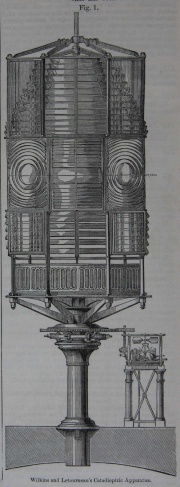1851 Great Exhibition: Official Catalogue: Class VII.: William Crane Wilkins


157. WILKINS, WILLIAM CRANE, 24 Long Acre, and T. LETOURNEAU, 37 Allee des Veuves, Paris — Manufacturer
Improved patent revolving catadioptric apparatus of short eclipses, for a lighthouse of the first class.
That appearance of light, called short eclipses, has hitherto been obtained by the following arrangements:— An apparatus for a fixed light being provided, composed of a central cylinder and two zones of catadioptric rings, forming a cupola and lower part, a certain number of lenses are arranged at equal distances from each other, placed upon an exterior moveable frame, making its revolution around the apparatus in a given period. These lenses, composed of vertical prisms, are of the same altitude as the cylinder, and the radius of their curves is in opposite directions to those of the cylinder, in such a manner that at their passing they converge into a parallel pencil of light; all the divergent rays, emitted horizontally from the cylinder, producing a brilliant effect, like that obtained by the use of annular lenses at the revolving lighthouses.
The first improvement exhibited has a special reference to the light, and produces a considerable increase in its power, whilst the simplicity of the optical arrangements is also regarded. It consists, firstly, in completely dispensing with the moveable central cylindrical lenses. Secondly, it replaces these by a single revolving cylinder, composed of four annular lenses, and four lenses of a fixed light introduced between them; but the number of each varying according to the succession of flashes to be produced in the period of revolution.
The second improvement, of which already some applications that have been made serve to show the importance, consists in a new method of arranging the revolving part, experience having shown that the arrangements at present in use are very faulty. A short time is sufficient for the action of the friction rollers, revolving on two parallel planes, to produce, by a succession of cuttings, a sufficiently deep groove to destroy the regularity of the rotatory movement. To obviate this great inconvenience, the friction rollers aro so placed and fitted on an iron axis, with regulating screws and traversing between two bevilled surfaces, that when an indentation is made in one place, they can be adjusted to another part of the plates which is not so worn.
The third improvement produces the result of an increase of the power of the flashes in revolving lighthouse apparatus, to double what has been obtained hitherto.
By means of lenses of vertical prisms, placed in the prolongations of the central annular lenses, the divergent rays emerging from the catadioptric zone are brought into a straight line, and a coincidence of the three flashes is obtained.
The whole of the prisms, lenses, and zones are mounted with strength and simplicity, accurately ground and polished to the correct curves, according to their respective positions, so as to properly develop this beautiful system of "Fresnel." The glass of which they are composed is of the clearest crystal colour, and free from that green hue which so materially reduces the power of the light, and is considered objectionable for apparatus of this kind. The lamp, by which the apparatus is to be lighted, consists of a concentric burner with four circular wicks, attached to a lamp of simple construction, the oil being forced up to the burner by atmospheric pressure only, so that there are no delicate pumps or machinery to become deranged.
Improved lantern and revolving apparatus for a light-vessel. The principle improvement consists, in constructing the machinery to work beneath the deck, instead of in the lantern as formerly. A vertical rod, working in metal bearings, is attached to the mast, with a large gun-metal pinion fixed to the top of the rod, at the height to which it is necessary to hoist the lantern, wherein a train of cog-wheels are placed to connect with the pinion, and communicate the motion obtained therefrom to the traversing apparatus that supports the lamps and reflectors. The advantages of this arrangement are, that the lanterns can be made much lighter, the rolling of the vessel caused by so great a weight at the mast-head is greatly diminished, and the machinery being more under control and better protected, works with greater regularity and precision.
An idea of the utility of these improvements may be gained by reflecting that the situations in which the light-vessels are placed, are at all times difficult of access, and in stormy weather, when accidents are most likely to occur, quite unapproachable; so that it will be obvious any alteration which reduces the liability to derangement is greatly to be appreciated.
There is also an advantage derived from the novel construction of the lamps and gimbal work which, by a movement, exactly coinciding with the motion of the vessel, causes a perfect level to be always maintained, and ensures the proper flow of oil to the burners, however irregular that motion may be. This improvement is not of so recent an introduction as the former, but when it was first invented by one of the exhibitors it produced a complete revolution in the apparatus for floating lights, and enabled the beautiful Argand lamps, with parabolic reflectors, to be used instead of the old lamps with smoky flat wicks.
Fig. 1 represents the catadioptric apparatus for lighthouses, and Fig. 2 the lantern for a light-vessel.

